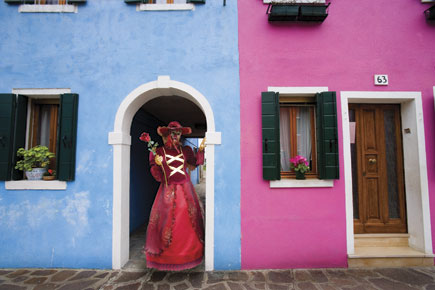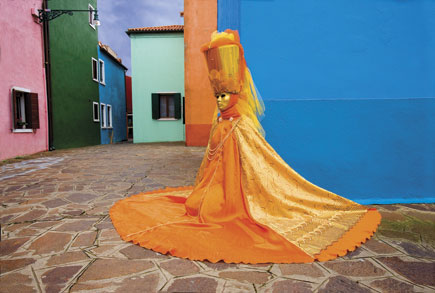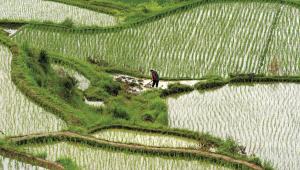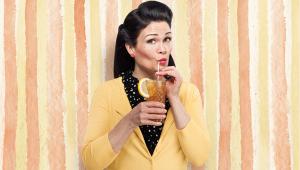Carnival In Venice; A Fashion Extravaganza Page 2
Carnival At Night
As evening descended on Venice, a new group of costumed people came out to show off their dazzling fashions. Instead of simply using flash as the only light source, I experimented with “dragging the shutter,” or using a low exposure in combination with the flash. Usually this is done when there is a lot of movement, like dancers or a motorcycle passing by. The flash freezes the subject while the long exposure creates a blur, and the two aspects are combined, or superimposed over each other, to create an artistic rendition of the subject. When I shot a Carnival participant posing for me, there was no movement at all.
 |
|
|
Instead, I created a sense of movement by moving the camera right after the flash was fired. I experimented with 1⁄4 and 1⁄2 sec shutter speeds, and after I triggered the flash I’d move the camera toward illuminated shop windows and the various streetlamps nearby. The result was an abstraction of light superimposed with the costumed models. I could use the immediate feedback on the camera’s LCD monitor to check the exposure as well as the artistic effect of the shutter speeds I used. I used the flash on E-TTL and the camera on Program, and this gave me the correct amount of light from the flash. I didn’t underexpose the flash as one might do when using fill flash outdoors because the ambient light from shop windows wasn’t bright enough to add exposure to the masked faces and costumes.
I liked the 1⁄2 sec shutter speed the most. It gave me enough time to move the lens past the night lights in Venice and to create an abstract pattern of light streaks over the subjects. I felt, though, that the abstracted lights were a little bright. I therefore reduced the amount of ambient light in the picture by choosing -2⁄3 EV on the exposure compensation function. This corrected the exposure and still allowed me the relatively long shutter speed that I wanted. To get the kind of abstraction I wanted, I used front-curtain sync, which means that the flash fires at the beginning of the time interval the shutter is open. This meant I could compose the subject, fire the flash to record the sharp image, and then move the camera toward the tungsten window lights.
 |
|
|
At the end of the four days in Venice, I shot about 40GB of raw images. That’s a huge amount of material to edit, but it was a labor of love because the pictures were so amazing.
The Carnival of Venice will be held from February 13-24, 2009.
Jim Zuckerman is one of the world’s best-known nature, wildlife, and travel photographers. His work has been sold in dozens of countries around the world in commercial, editorial, and fine art venues. Zuckerman is also a respected photo educator and the author of 12 books on a wide range of photographic subjects. He leads international photo tours to exotic destinations such as Burma, Morocco, Turkey, Papua New Guinea, Peru, Indonesia, and Africa.
 |
|
|
The Digital Approach
When I shot film, I always felt comfort in knowing that when I took a picture I could hold it and touch it whenever I wanted. A lab could make a mistake in processing and ruin a roll of film, but that didn’t happen often. With digital captures, all we have are invisible electronic zeros and ones. If a flash card has a hiccup, the images that I worked so hard to get vanish. If a portable hard drive gets knocked off a desk, a data recovery service may or may not be able to salvage my investment in time or money.
What I do now is carry two portable hard drives with me. It’s now standard equipment in my photo backpack. As soon as I fill up a flash card, I put it into one of my Epson P-4000s, put a new card into the camera, and as I continue shooting I’m downloading images to the hard drive. After 10 minutes or so I take the flash card out of the first Epson and put it into the second one and download the entire card again as my first backup. Then, later in the evening, I download the same images to my laptop and transfer them to a very small LaCie 100GB drive. This is my second backup. I won’t reformat the card until I’ve seen the images come up on all three drives. (It’s a good idea not to shoot every frame available on a card—instead, change to a new card when you’ve exposed 95 percent of it. This is a good way to prevent the card from crashing.)
I tend to prefer 2GB cards because they download quicker than 4GB and 8GB cards and I don’t have as many eggs in one basket. In other words, if there is a problem, I won’t lose as many shots. However, I was shooting so many pictures so fast at Carnival that I used 4GB cards because I didn’t have to change them as often.
You can sign up for his mailing list at: jimzuckerman.com. He also teaches online photography courses at BetterPhoto.com.
- Log in or register to post comments

















































